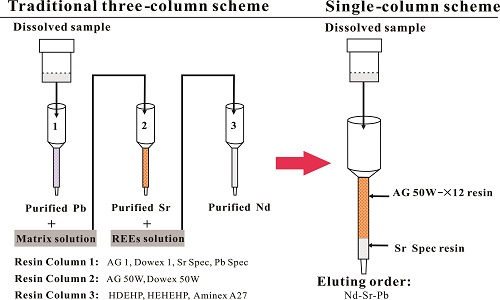|
Secondary Ion Mass Spectrometer Laboratory
|
Press
A rapid single column separation scheme for high precision Sr–Nd–Pb isotopic analysis in geological samples using thermal ionization mass spectrometrySr, Nd, and Pb isotope ratios are routinely used for geochemical and environmental tracing, and for interpreting the evolution of the lithosphere, source provenance, as well as atmospheric circulation and transport. Thermal ionization source mass spectrometry (TIMS) is regarded as a benchmark analytical technique and is widely used in Earth Sciences because of its high accuracy, excellent sensitivity, and low memory. However, to obtain stable and high intensity ion signals from Sr–Nd–Pb during measurements of TIMS, elements must be separated from sample matrices as cleanly as possible. Traditionally, for Sr, Nd and Pb isotope analyses using TIMS, column chemistry, which includes many tedious evaporation and complex operation steps, is the most commonly used approach. The purification of Sr–Nd–Pb prior to mass spectrometric measurements is traditionally accomplished by three column chromatography after single sample digestion. Thus, traditional three column methods are complex and the separation efficiency is low. In addition, traditional separation procedures might increase contamination risks from cross-operation in column chemistry associated with the complex operation steps. In this study, a single column chemistry separation procedure for Sr–Nd–Pb from single rock dissolution was developed by Li Chaofeng and co-authors (State Key Laboratory of Lithospheric Evolution, Institute of Geology and Geophysics, Chinese Academy of Sciences). The chemistry procedure was designed to minimize the number of evaporation steps and considerably shorten the time required for separation and enable high throughput for TIMS. In contrast to conventional three column separation procedures (3 days), this technique is rapid, in terms of separation time (8 hours), and highly efficient, with a 3-fold enhancement in the separation efficiency. The proposed separation procedure achieves the satisfactory purity and rapid separation of Sr, Nd, and Pb and reduces cross-contamination risks. As such, the proposed procedure offers significant advantages over existing methods in terms of simplicity, separation efficiency and waste reduction. The bottleneck associated with sample preparation prior to thermal ionization mass spectrometric measurements can be significantly reduced with the new chemical separation protocol.
Figure: Traditional three-column scheme VS sigle-column scheme This work was published in Analytical Methods(Li, C.-F., Chu, Z.-Y., Guo, J.-H., Li, Y.-L., Yang, Y.-H., Li, X.-H., 2015. A rapid single column separation scheme for high-precision Sr-Nd-Pb isotopic analysis in geological samples using thermal ionization mass spectrometry. Analytical Methods, 7, 4793-4802, doi: 10.1039/C4AY02896A).(Link) Contact:
|
-
SIMSSecondary Ion Mass Spectrometer Laboratory
-
MC-ICPMSMultiple-collector ICPMS Laboratory
-
EM & TEMElectron Microprobe and Transmission Electron Microscope Laboratory
-
SISolid Isotope Laboratory
-
StIStable Isotope Laboratory
-
RMPARock-Mineral Preparation and Analysis
-
AAH40Ar/39Ar & (U-Th)/He Laboratory
-
EMLElectron Microscopy Laboratory
-
USCLUranium Series Chronology Laboratory
-
SASeismic Array Laboratory
-
SEELaboratory of Space Environment Exploration Laboratory
-
PGPaleomagnetism and Geochronology Laboratory
-
BioMNSFrance-China Bio-mineralization and Nano-structure Laboratory


